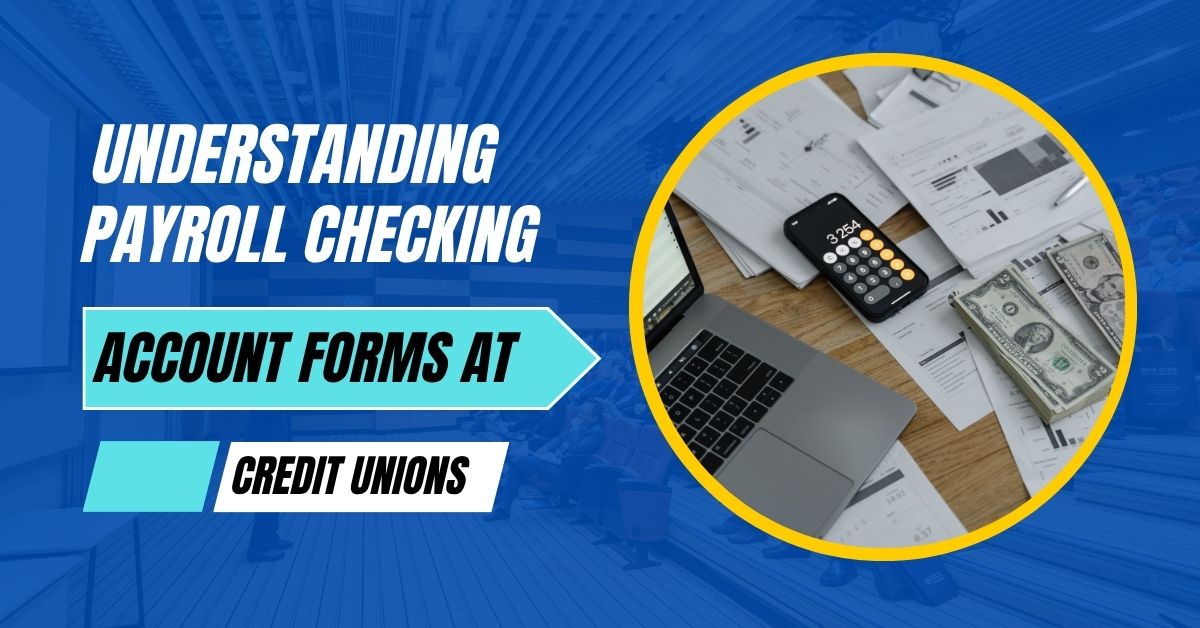Understanding Payroll Checking Account Forms at Credit Unions
A Payroll Checking Account Form at a credit union is an important document that helps members set up direct deposit of their salary or wages into their checking account. It’s a simple but very useful form that makes your money management easier and more secure.
What is a Payroll Checking Account Form?
A Payroll Checking Account Form is a form you fill out to tell your employer where to send your paycheck. Instead of receiving a paper check, your employer will deposit your wages directly into your credit union checking account. This process is called direct deposit.
The form includes your name, credit union account number, the routing number, and the type of account (checking or savings). You might also need to attach a voided check or a letter from your credit union.
What is a Credit Union?
Before we go further, let’s understand what a credit union is. A credit union is like a bank, but it is not-for-profit and is owned by its members. It offers many of the same services as banks such as loans, savings accounts, and checking accounts—but often at better rates and lower fees.
Unlike large banks, credit unions focus on helping their members and their local communities. They are also known for providing more personalized service.
Why Use a Payroll Checking Account Form?
There are several benefits of using a payroll checking account form:
- Faster Access to Your Pay
Direct deposit is much quicker than waiting for a check. Most people get paid automatically on payday—no waiting, no standing in line at the bank. - More Secure
A paper check can be lost or stolen. Direct deposit is safe because it goes straight into your account. - No Extra Trips
You don’t have to visit a branch to deposit your paycheck. Everything happens automatically. - Better Budgeting
With your money going directly into your checking account, it’s easier to track spending, pay bills on time, and budget. - Access to Perks
Many credit unions offer benefits if you use direct deposit—like lower fees, overdraft protection, or easier loan approval.
What Does the Payroll Checking Account Form Include?
Here is a breakdown of the most common fields you’ll see on a payroll checking account form:
| Field | Description |
|---|---|
| Name | Your full name as it appears on your account |
| Employer Name | The name of the company paying you |
| Credit Union Name | The name of the credit union where your account is |
| Account Number | The number linked to your checking account |
| Routing Number | A 9-digit number that identifies your credit union |
| Account Type | You must select “checking” or “savings” |
| Signature | You sign to give permission for direct deposit |
| Date | The date when you filled out the form |
Some employers or credit unions may have extra sections, such as split deposits (sending part of your pay to savings), but these are optional.
How to Fill Out the Payroll Checking Account Form
Filling out the form is usually easy. Here’s a step-by-step guide:
- Get the Form
You can request the form from your employer or download it from your credit union’s website. - Gather Information
You’ll need your credit union’s routing number and your account number. These are usually found on the bottom of your checks or in your online banking profile. - Fill It Out Clearly
Use black ink or fill it out online if available. Make sure all details are correct. - Attach a Voided Check (If Required)
Some employers may ask for a voided check to verify your account. Just write “VOID” across a blank check. - Submit the Form
Give the completed form to your employer’s HR department or payroll officer.
What If You Change Credit Unions?
If you move to a new credit union or change accounts, you’ll need to submit a new payroll checking account form to your employer. This ensures your pay goes to the correct place.
It may take 1-2 pay cycles for the change to be effective, so keep your old account open until you confirm the first direct deposit in the new one.
Credit Unions and Better Financial Health
Many people choose credit unions because they offer lower fees and better service. When your paycheck goes directly into a credit union checking account, you can enjoy benefits like:
- Free or low-cost checking
- No minimum balance fees
- Easy access to loans
- Member-focused customer service
Because credit unions are not-for-profit, any money they make is returned to members in the form of better rates and services. This is part of what makes credit unions so attractive.
You can learn more about the benefits of credit unions from Cooperative, since credit unions are a type of financial cooperative.
Things to Remember
- Double-check your account and routing numbers. One small mistake can delay your pay.
- Keep a copy of the completed form for your records.
- If you change jobs, you’ll need to fill out a new form for your new employer.
- Some credit unions allow you to set up direct deposit online or through their mobile apps.
Common Questions
1. Can I split my paycheck between checking and savings?
Yes. Many payroll forms let you divide your paycheck. You might want part of your pay to go into savings automatically.
2. What if I don’t have checks?
Ask your credit union for a direct deposit letter. This will include your routing and account number and can be used instead of a voided check.
3. Is this form the same at all credit unions?
No, the design might vary, but the basic information is usually the same.
4. How long does it take for direct deposit to start?
It usually takes one or two pay cycles. In the meantime, your employer may give you a paper check.
5. Is my information safe?
Yes. Payroll forms are handled securely. Your employer and credit union use encryption and security protocols to protect your data.
Conclusion
A Payroll Checking Account Form at a Credit Union is a simple but very important tool. It makes getting your paycheck faster, safer, and more convenient. By using this form, you can take control of your money and avoid the stress of paper checks.
Credit unions are an excellent choice for managing your finances, and direct deposit is one of the easiest ways to get started. Always make sure your form is accurate, keep a copy for your records, and enjoy the peace of mind that comes with modern, direct banking.
Also Read:
- How to Do Payroll for a Construction Company?
- What Happens If a Company Can’t Make Payroll?
- Who Is Responsible If a Payroll Check Bounced?
- How to Reconcile Payroll?
- How to Fix Payroll with AI?
Frequently Asked Questions
What is a payroll checking account form used for?
A payroll checking account form is used to let your employer know where to send your paycheck. By filling it out, you can have your salary directly deposited into your credit union checking account safely and quickly without waiting for paper checks or visiting a bank.
How do I get my credit union routing number?
You can find your routing number on your checks (usually the first 9 digits at the bottom) or by logging into your online banking account. You can also call or visit your credit union and ask for it directly. It’s important to use the correct number.
Is direct deposit better than paper checks?
Yes, direct deposit is usually better than paper checks. It’s faster, more secure, and saves you time. You don’t have to go to the bank to deposit a check, and you don’t risk losing it. Your money goes straight into your account on payday.
Can I use a savings account for direct deposit?
Yes, you can. Most payroll forms let you choose between a checking or savings account. Some people even split their pay between both. Just make sure you provide the correct account and routing numbers to avoid any issues with where your money goes.
What if I change my credit union later?
If you switch credit unions, you’ll need to fill out a new payroll checking account form and give it to your employer. It may take 1–2 pay periods for the change to take effect, so keep your old account open until the deposit shows in the new one.


